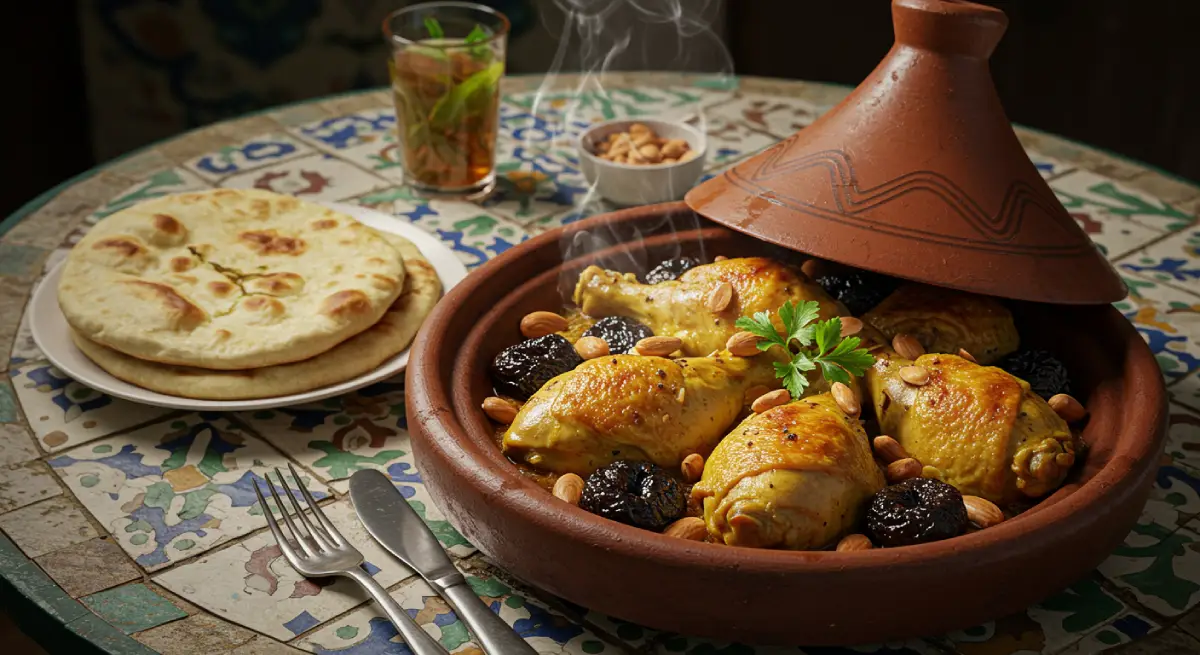
Table of Contents
The Day I Learned the Real Secret to Moroccan Cooking
Four a.m. The roads of Rabat were still asleep.
My white taxi wasn’t working, not really. This was a Family trip. My wife is beside me, our kids, Salma and Hamza, in the back. We had a long haul ahead—600 kilometers down to Agadir.The reason? A celebration. My sister-in-law, Hasna’s daughter, had just passed her big exams, and an invitation from Hasna was basically a command performance. You just had to be there.
Ten hours on the road is no joke. We walked in completely wiped out.
But then Hasna opened her door. And that smell… it hit you right away. Warm cinnamon, sharp ginger, and something deeply sweet, all tangled together. It was the smell of a promise. The promise of a feast.
She sat us down, and there it was. In the middle of the table sat this incredible, giant platter, a Taos, piled high with chicken. So golden it almost glowed. And the prunes. So many dark, glistening prunes, swimming in a sauce so thick you could see it clinging to the meat. That’s what we call Daghmira..
I was starving. We all were. I just started eating. Honestly, every piece of bread was just a vehicle for that sauce. I couldn’t get enough.
Finally, I had to know. “Hasna, what did you do to this? Seriously. What’s the secret?” I was expecting a complicated answer. Some rare spice I’d have to hunt down in a souk.
She just looked at me and laughed. That warm laugh of hers.
“Khalid, brother-in-law,” she said. “Secret? There’s no secret. You just have to want to make it. And you have to be patient. Let it cook slowly. Give it all the time it asks for… and then, just give it a little more.”
That was it. That was the whole lesson. The best tagine of my life, and the secret was simply patience.
So, this is that recipe. It’s Hasna’s wisdom in a pot. The real deal.
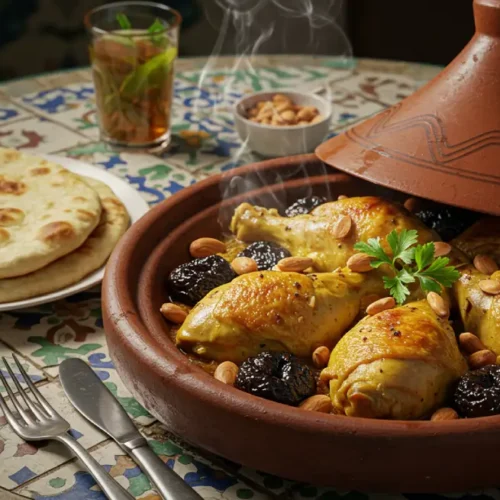
The Ultimate Chicken Tagine with Prunes and Cinnamon
Equipment
- 1 Dutch oven or heavy-bottomed pot (or a traditional Tagine pot)
- 1 Large bowl for marinating
Ingredients
Ingredients
- 8 bone-in skin-on chicken thighs (about 3 lbs / 1.5 kg)
- 2 large yellow onions thinly sliced
- 4 cloves garlic minced
- 1 tbsp fresh ginger grated
For the Spice Rub:
- 1 ½ tsp ground ginger
- 1 tsp ground turmeric
- 1 tsp salt
- ½ tsp black pepper
- ½ tsp ground cinnamon
- A generous pinch of saffron threads
For the Sauce & Garnish:
- 3 tbsp olive oil
- 2 cups chicken broth
- 1 cup pitted prunes about 200g
- 1 cinnamon stick
- 2 tbsp honey
- ½ cup toasted slivered almonds
- 2 tbsp sesame seeds toasted
- Fresh cilantro or parsley chopped (for garnish)
Instructions
Instructions
- Marinate the Chicken:
- In a large bowl, combine the chicken thighs with the spice rub ingredients (ground ginger, turmeric, salt, pepper, ground cinnamon, saffron). Add the minced garlic and grated fresh ginger. Rub the mixture all over the chicken, getting it under the skin. Cover and let it marinate in the fridge for at least 1 hour, or overnight for the best flavor.
- Sear the Chicken:
- In your Dutch oven or pot, heat the olive oil over medium-high heat. Place the chicken thighs skin-side down and sear for 5-7 minutes until the skin is golden brown and crispy. Flip and sear the other side for 2 minutes. Don’t overcrowd the pot; do this in batches if needed. Set the seared chicken aside on a plate.
- Build the Flavor Base:
- Lower the heat to medium. Add the sliced onions to the same pot and cook slowly for about 10 minutes, stirring occasionally, until they are soft and translucent.
- The Slow Simmer:
- Return the seared chicken to the pot, placing it on top of the onions. Add the chicken broth and the cinnamon stick. Bring it to a gentle simmer, then reduce the heat to low, cover the pot, and let it cook slowly for 1 hour.
- Add the Sweetness:
- After 1 hour, add the prunes and drizzle the honey over the chicken. Gently stir everything together. Cover again and continue to simmer for another 20-30 minutes, until the chicken is fall-off-the-bone tender and the sauce has thickened.
- Garnish and Serve:
- To serve, transfer the chicken and sauce to a large platter. Sprinkle generously with the toasted almonds, sesame seeds, and fresh cilantro or parsley. Serve immediately with warm Moroccan bread (khobz) or couscous.
Notes
- Soaking the prunes: For extra plump prunes, you can wash them in warm water for 20 minutes before adding them to the pot.
- Sauce Consistency: If your sauce is too thin at the end, remove the chicken and prunes, and let the sauce simmer uncovered for a few minutes to reduce and thicken.
- Patience is Key: This isn’t a dish to rush. The long, slow simmer is what makes the chicken incredibly tender and the sauce so rich. This is Hasna’s secret!
A Step-by-Step Visual Guide to Hasna’s Chicken Tagine
Okay, ready? Let’s get to it. This isn’t about being a perfect chef. It’s about feeling the food. I’ll show you exactly what my sister-in-law, Hasna, does. No secrets kept.
Step 1: Marinate the Chicken. Really Marinate It.
First things first. The chicken. It needs flavor, and not just on the surface. Deep down.
Get a big bowl. Toss in the chicken thighs, then all your dry spices—ginger, turmeric, salt, pepper, the cinnamon, and don’t forget that saffron. It’s special. Then the fresh stuff, the garlic and ginger.
Now, don’t be shy. Get your hands in there. Rub that mix all over. I mean everywhere. Under the skin is where the magic really happens. You’re not just coating it; you’re telling it what to do. Now cover it up, stick it in the fridge. An hour is fine if you’re in a hurry. But overnight? That’s when the flavor really becomes part of the chicken.
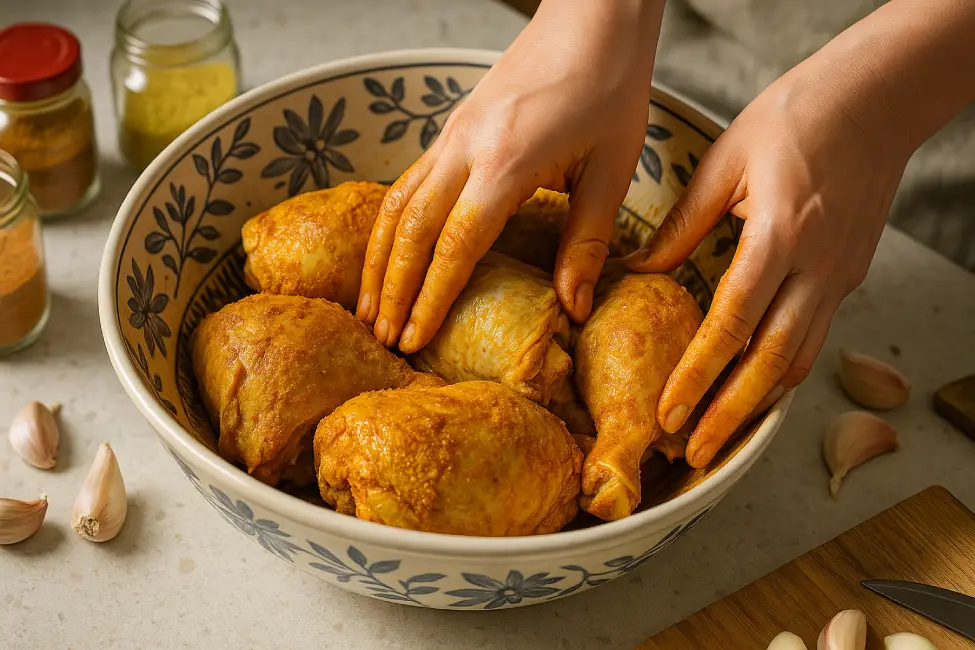
Step 2: Get a Good Sear. It Matters.
This step is all about that beautiful brown crust. It’s not just for looks. Its flavor.
Get your pot hot—a heavy Dutch oven is your best friend here. Add the olive oil. Wait ’til it shimmers a little. Then, carefully, lay the chicken in, skin-side down.
You hear that sizzle? That’s the good stuff. Now, hands off. Don’t move it. Don’t poke it. Let it sit for a good 5-7 minutes. Let the skin get crispy and brown. Seriously brown. Flip it, give it a minute on the other side, and then get it out of the pot.
Do it in batches if you have to. A crowded pan just steams the chicken, and we don’t want that.
Step 3: Sweeten Up Those Onions.
Look inside your pot. See all those brown bits stuck to the bottom? That’s gold. Pure gold.
Lower the heat. Throw your sliced onions right on top of that.
Let them cook in all that leftover chicken goodness. Let them get soft and sweet. This takes a little time, maybe ten minutes. Don’t rush them. This is the heart of your Daghmira sauce.

Step 4: The Long, Slow Simmer. Hasna’s Secret.
Time to bring everyone back to the party. Put the seared chicken back in the pot, right on top of those sweet onions. Pour in the chicken broth. Toss in that cinnamon stick.
Turn the heat up just for a minute to get a nice, slow bubble going. That’s a simmer. Perfect. Now, turn the heat way, way down. As low as it goes. Lid on.
And now? You wait for one hour. Go do something else. Have some tea. This is what Hasna was talking about. Patience. Don’t lift the lid. Trust me.
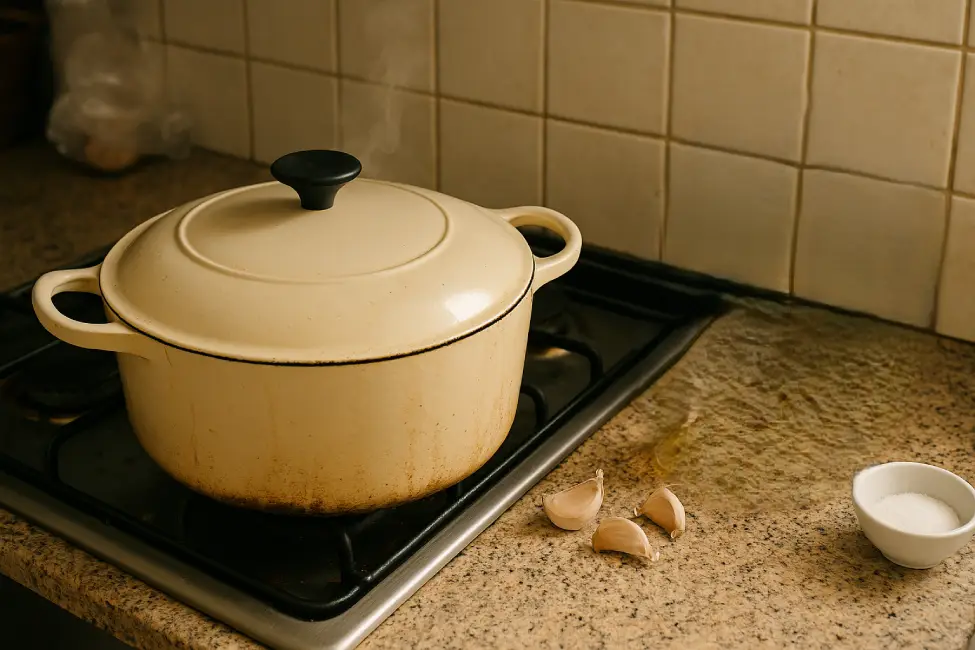
Step 5: The Sweet Finish. Prunes and Honey.
Okay, it’s been an hour. Your whole house smells amazing, right?
Lift the lid. Now for the magic. Drop the prunes in. Drizzle the honey all over everything. Give it a gentle nudge with a spoon so it all gets friendly.
This is the moment it becomes a true Moroccan celebration dish. That perfect sweet and savory mix.
Lid back on. Just another 20-30 minutes. The chicken will get so tender it’ll practically melt. The prunes get all jammy. The sauce gets thick and incredible. Almost there.
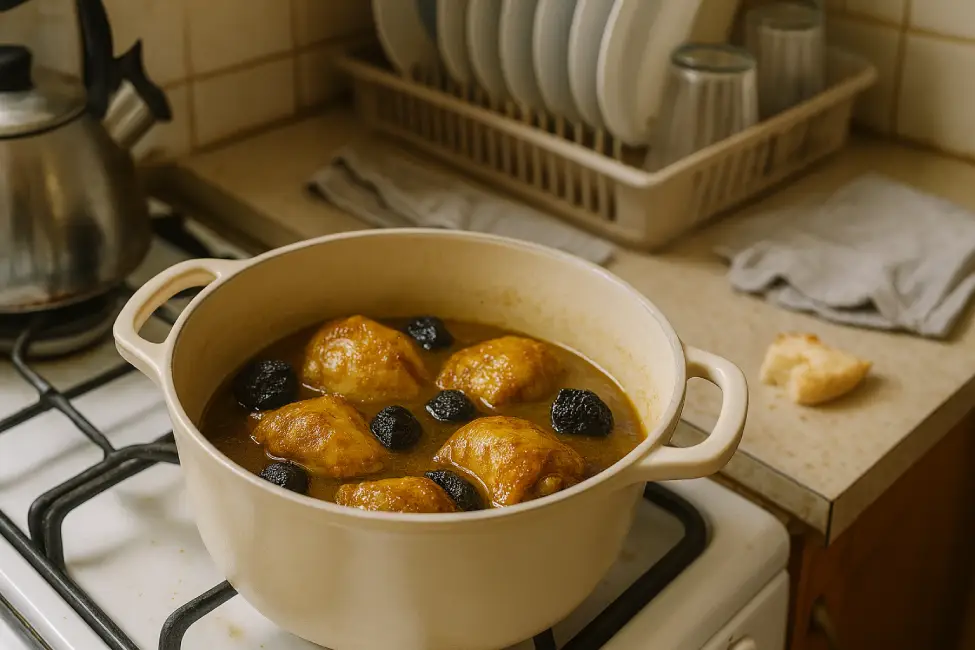
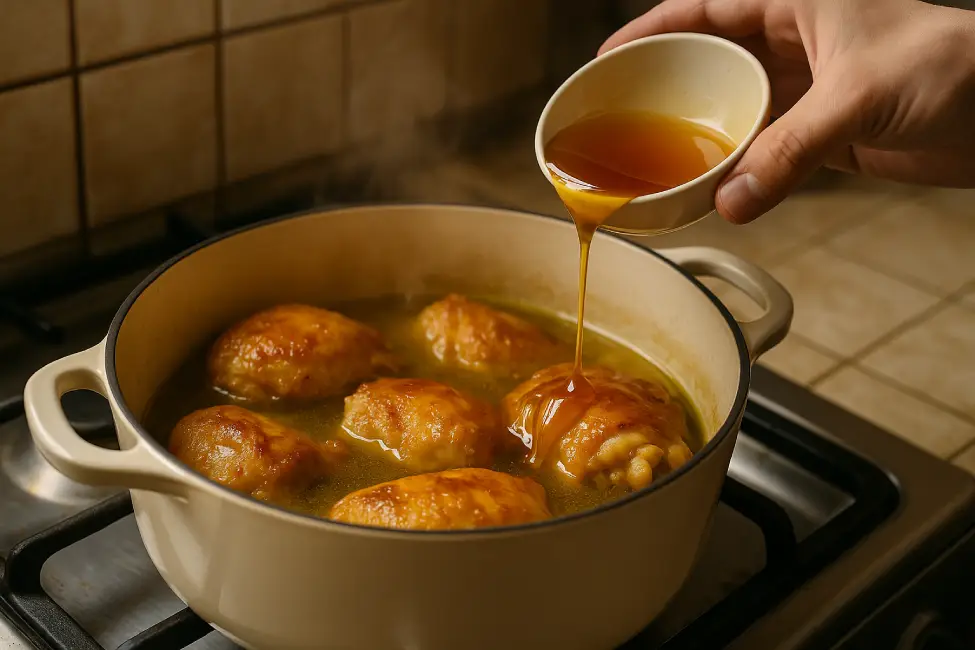
Step 6: The Grand Finale. The Crunch.
This is how you present it. This is the part that gets the “wows.”
Move the chicken and all that glorious sauce to a big platter. That Taos platter, if you have one. Don’t be shy with the almonds and sesame seeds. Sprinkle them all over. That crunch against the soft chicken is everything.
Then, a little fresh cilantro or parsley on top for color.
Done. Bring it to the table, hot. Make sure there’s plenty of bread. Nobody’s going to want to waste a single drop of that sauce.
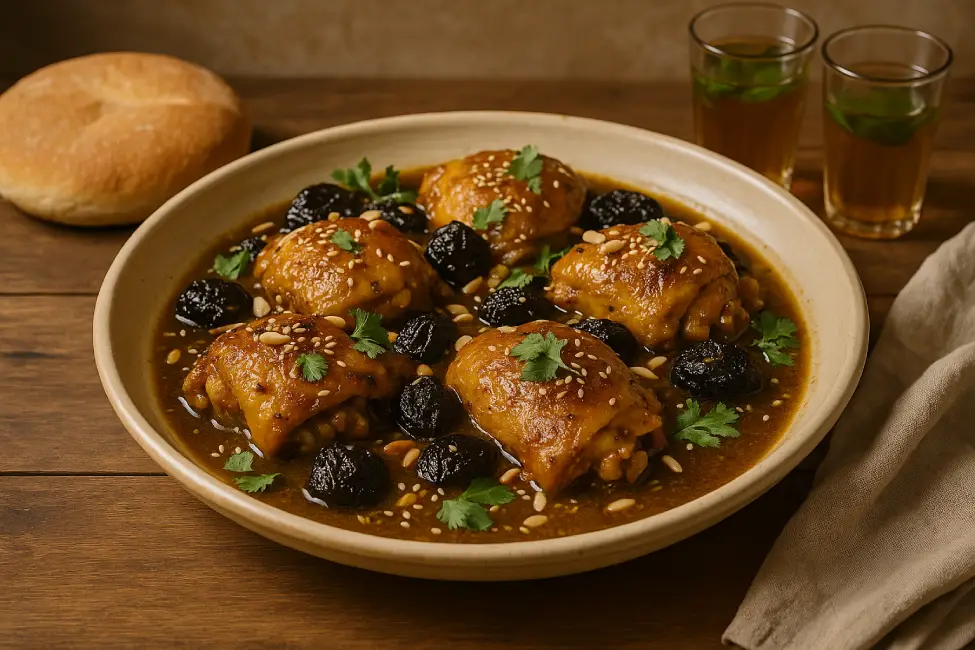
The Story Behind This Recipe: A 600km Drive for a Taste of Home
This recipe? It’s not from a cookbook. It’s from a memory. A long drive, a Family party, and a lesson I learned from my sister-in-law that changed everything.
A Family Road Trip and a Baccalaureate Celebration
Picture this. It’s four a.m. Dark. I’m in my taxi, but I’m not working. My Family’s packed in. My kids, Salma and Hamza, are passed out in the back. We’re driving. A long, long drive from Rabat to Agadir. 600 kilometers.
Why? For a party. My niece had just passed her baccalaureate exams. A huge deal in Morocco. My sister-in-law, Hasna, was throwing a feast, and you just don’t miss one of Hasna’s feasts. Period.
The Feast on the “Taos” Plate
We got there feeling like we’d been on the road for a week. Totally drained.
But then Hasna opened the door. And that smell… cinnamon, spices, chicken. It hits you and suddenly, you’re not tired anymore. You’re just hungry.
The table was set. Little plates of salads everywhere. But in the middle, this massive platter. A Taos. On it? Three whole chickens, golden and practically glowing. Covered in a mountain of dark, sticky prunes. And the sauce. Oh, that sauce. A thick, rich, brown gravy we call Daghmira. It wasn’t just food. It was a masterpiece.
The Secret Isn’t an Ingredient, It’s an Intention
I don’t think I spoke for the first ten minutes. Just ate. We all did. The chicken just fell off the bone. The prunes were sweet, the sauce was savory. It was perfect.
I had to ask her. “Hasna, come on. What’s the secret? What did you do?” I was ready for some complicated, ancient technique.
She just laughed.
“Khalid,” she told me, “there’s no secret spice. You know how to make this. The only secret is you have to feel it. You have to want to make something wonderful. Then, you give it time. A low fire. Let it cook. And when you think it’s done? Give it a little more time.”
That’s it. That was the whole secret. Patience. And cooking with your heart.
The Key Ingredients That Make This Tagine Unforgettable
Look, good food isn’t complicated. It’s about using the right stuff. For this tagine, a few key things make all the difference. Get these right, and you’re golden.
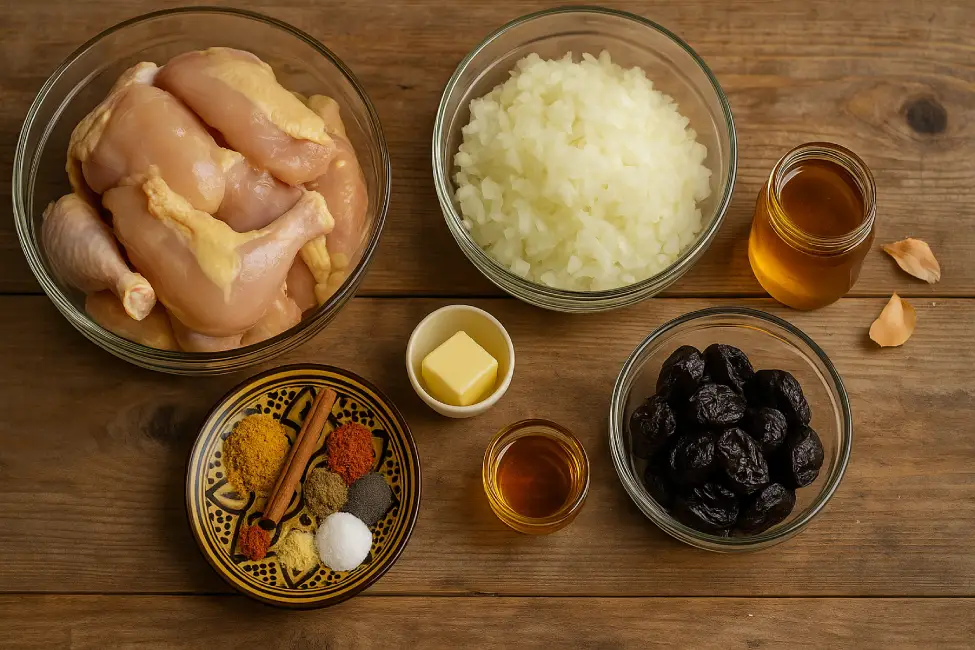
Why Bone-In Chicken is a Must
Seriously. Don’t even think about using boneless breasts. You’ll end up with dry, sad chicken.
You need bone-in. Thighs are the best. Legs are great too. All the real flavor is locked in that bone. It slowly releases into the sauce and keeps the meat from drying out.
You want chicken that falls apart when you touch it with a fork? This is how you get it.
Get Good Prunes. It Matters.
Not all prunes are the same. Forget the little dry ones in a box. You want the good stuff. Plump, sticky, dark prunes. And make sure they’re pitted. Saves everyone a lot of trouble later.
Here’s a tip: Soak them. Just put them in a bowl of warm water for 20 minutes before you cook. They get super soft and jammy. Trust me on this one.
- Sure, people will tell you about the health benefits of prunes. Good for you. But we’re here for the flavor. And this trick makes the flavor incredible.
The Spices: Cinnamon, Ginger, Saffron
This isn’t a “dump-a-bunch-of-powder-in” kind of dish. Three main players do all the work.
- Cinnamon. Get a real stick for the pot. It perfumes the whole dish. A little powder for the marinade is good too. It’s that warmth.
- Ginger. Fresh. Always fresh. Grate it yourself. It’s got a bright kick that keeps the sweet prunes in check.
- Saffron. The good stuff. Yeah, it costs a bit. But you only need a tiny pinch. It gives the tagine that beautiful golden glow and a smell that’s just… celebration.
- Have you ever wondered why saffron is so expensive? It’s a whole story. But that unique flavor is what separates a good meal from a great one.
The Garnish. Don’t You Dare Skip It.
This is not optional. I mean it.
Toasted almonds. Toasted sesame seeds. You need that crunch at the end. It’s the whole point. You’ve got this super tender chicken, these soft, sweet prunes, this thick sauce… and then crunch. That’s the texture that makes it perfect. Don’t skip it.
- This whole idea of balancing flavors and textures is at the heart of our cooking. I discuss the basics in The Ultimate Guide to Authentic Moroccan Tagine.
Pro Tips & FAQ: Your Questions Answered
People ask me stuff all the time. Here are the real answers. No fluff.
But Khalid, I don’t have a tagine pot!
So what? You don’t need one.
Listen, I love my clay pot. It’s traditional. It looks great. But is it magic? No. A heavy pot with a good lid will get you 99% of the way there. A Dutch oven is perfect. The whole game is trapping the steam and cooking slowly. That’s it. Your heavy pot can do that just fine.
Want to get nerdy about how a tagine pot works versus a Dutch oven? Go for it. But don’t let not having one stop you from making this. That would be a crime.
My sauce is too thin! Help!
Easy fix. Happens to everyone.
First, the real secret to a thick Daghmira is just time. Slow cooking. The onions basically melt. That’s what makes it dense.
But if you’re at the end and it’s still a bit watery? Don’t panic. Just lift the chicken and prunes out of the pot for a second. Crank the heat up a bit. Let that sauce bubble and reduce. Five minutes, maybe ten. It’ll thicken right up. Then just put the chicken back in. Done.
When do I add the prunes? Mine turned to mush.
Right. You don’t want prune soup.
Here’s the rule: last 30 minutes. No sooner. That’s all they need. They’ll get soft, sweet, and jammy, but they’ll still look like prunes. Any longer and they just fall apart. Timing is everything here.
Can I use apricots instead?
Of course you can. Why not?
Prunes are the classic for this dish. But dried apricots are amazing too. They give it a tangier kick. Dried figs work too, but they’re sweeter. Just swap them out. Same amount. The recipe doesn’t change. Make it your own.
This is the sweet and savory version. If you want to try a completely different style, like with lemons and olives, I’ve got other Chicken Recipes for you to check out.
How to Serve This Tagine Like a True Moroccan Family
Okay, you cooked the masterpiece. Now what? Don’t just scoop it onto a plate with a fork. Serving this dish is part of the experience. It’s about sharing. Here’s how we do it at home.
The Perfect Sides: It’s All About the Bread
Forget rice. Forget pasta. For a tagine like this, you need one thing: bread. Good bread.
In Morocco, we have Khobz. A round, slightly crusty bread that’s perfect for the job. Your job? Tearing off a piece and using it to scoop up everything. The chicken, the prunes, and most importantly, that sauce. You’re not leaving a single drop of that Daghmira behind. That’s the rule.
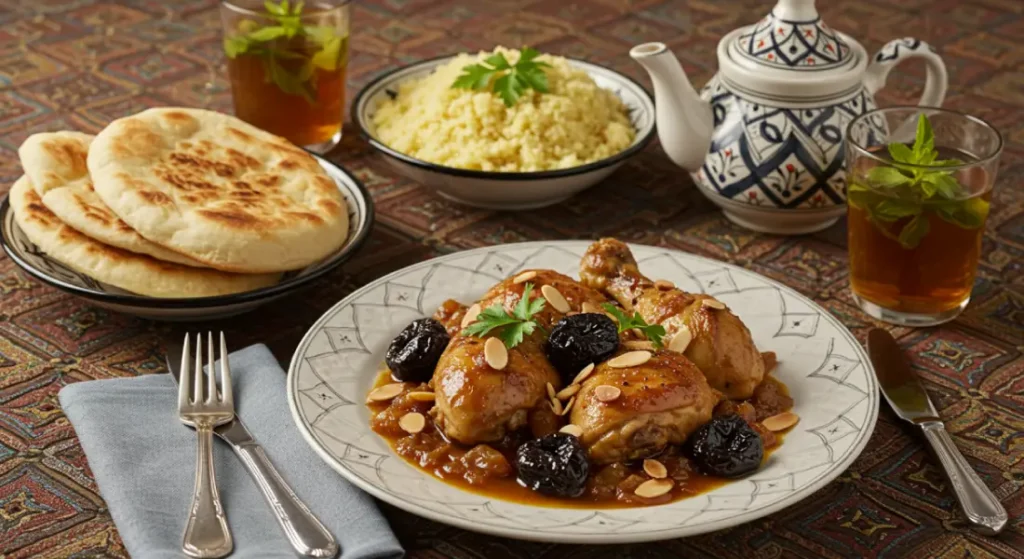
If you want to serve couscous, you can. It’s also great for soaking up the sauce. But for me, bread is the true way.
- A simple Moroccan Couscous is always a crowd-pleaser if you want to offer both options.
The Right Drink: Sweet Mint Tea, of Course
What do you drink with something this rich and flavorful? Something to cut through it.
Forget wine. The real pairing is Moroccan mint tea. Hot, sweet, and full of fresh mint. It cleanses your palate between bites. It helps with digestion. It’s just… right. It’s what we drink after every big meal. It’s part of the ritual.
- The ritual of Moroccan mint tea is a whole ceremony in itself. It’s a symbol of hospitality that’s as important as the food.
And the Leftovers? They’re Even Better.
Here’s a little secret for you. This tagine is incredible the next day. Maybe even better.
Seriously. Let it sit in the fridge overnight. The flavors get to know each other. They deepen. The sauce gets even richer. Just reheat it gently on the stove. Don’t microwave it, you’ll dry out the chicken. A slow reheat is all it needs. Eating it with some fresh bread for lunch the next day? That’s one of life’s simple pleasures.
- This idea of slow-cooked food getting better over time is the heart of our cuisine. You can see it in all our dishes, from this tagine to the rich flavors of our Vibrant Moroccan Cuisine.
My Final Thought: It’s More Than Just a Recipe
And that’s it, really.
That’s the recipe for Hasna’s tagine. But it was never just about the chicken and prunes, was it?
It’s funny. You think you’re just driving to a party, and you end up learning something you’ll never forget. Hasna taught me that the best food isn’t complicated. It’s just honest. It’s made with that feeling, that l’envie, of really wanting to cook for people you care about.
And patience. Lots of patience.
So please, make this. Take your time with it. Let your whole house fill up with that incredible smell.
And then, share it. That’s the most important step in the recipe, anyway.
📌 Nutrition Information (Per Serving)
| Nutrient | Amount per Serving | % Daily Value* |
|---|---|---|
| Calories | 650 kcal | 24% |
| Protein | 28 g | 56% |
| Total Fat | 22 g | 34% |
| Saturated Fat | 4 g | 20% |
| Cholesterol | 90 mg | 30% |
| Total Carbohydrates | 38 g | 13% |
| Dietary Fiber | 5 g | 20% |
| Sugars | 18 g | — |
| Sodium | 720 mg | 30% |
| Potassium | 750 mg | 21% |
| Vitamin A | 25% | |
| Vitamin C | 15% | |
| Iron | 20% | |
| Calcium | 8% |
Important Notes:
- The values are approximate and may vary depending on portion size and specific ingredients used.
- Nutritional information is calculated for one serving (about 1/4 of the full tagine recipe).
- The table follows common nutritional labeling standards used in food blogs and e-commerce.
📌 Stay Connected & Join Our Moroccan Food Community!
🌟 Follow me on social media for more traditional Moroccan recipes, kitchen tips, and inspiring food stories. From step-by-step tutorials to behind-the-scenes cooking moments, let’s share the joy of Moroccan cuisine together.
💬 I’d love to see your own creations — tag me when you make this dish or any other Moroccan recipe! Let’s turn every meal into a celebration. 🥘🎉
Join Me on the Road to Flavor
My journey collecting recipes across Morocco is far from over. Subscribe to my newsletter and I’ll send you new, authentic dishes and the stories behind them, straight from my kitchen to your inbox. It’s more than a mailing list—it’s an invitation to share a piece of my Morocco.
📩 Join Our Moroccan Foodie Community
Get the best Moroccan tagine recipes and seasonal culinary tips straight to your inbox.
❓ Need Help or Have Questions?
If you encounter any questions while preparing this chicken tagine or want advice on ingredient substitutions, don’t hesitate to ask in the comments below! I’m here to help you make your Moroccan cooking experience enjoyable, easy, and successful. Let’s make sure your dish turns out perfect!
💬 Your Turn — Share Your Experience!
Have you tried this chicken tagine with prunes and cinnamon at home?
I would love to hear how it turned out for you! Feel free to share your tips, adjustments, or even family memories linked to Moroccan dishes. Your comments and feedback help keep the spirit of Moroccan cooking alive — and might inspire others, too!
